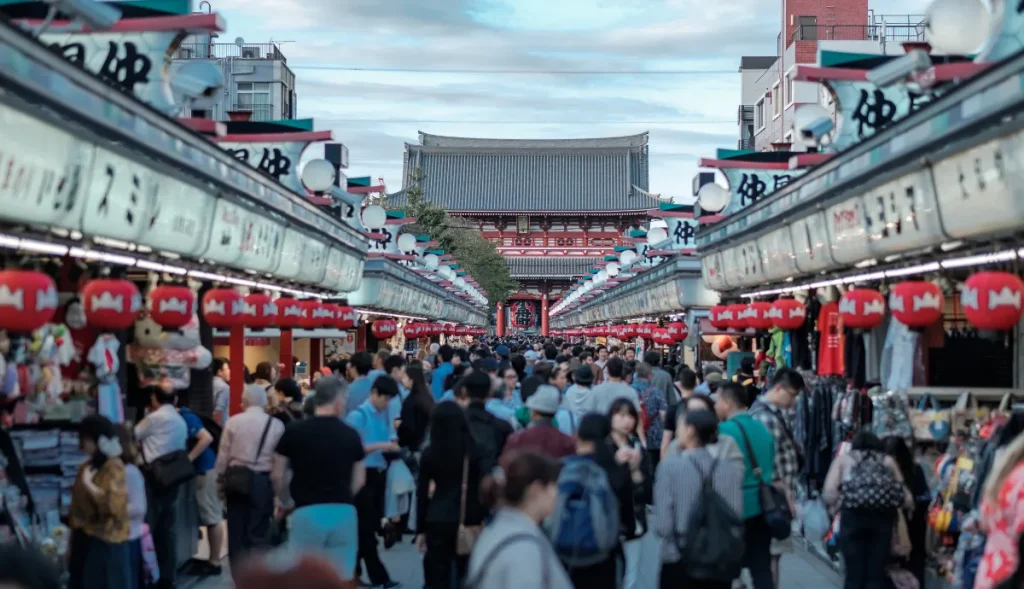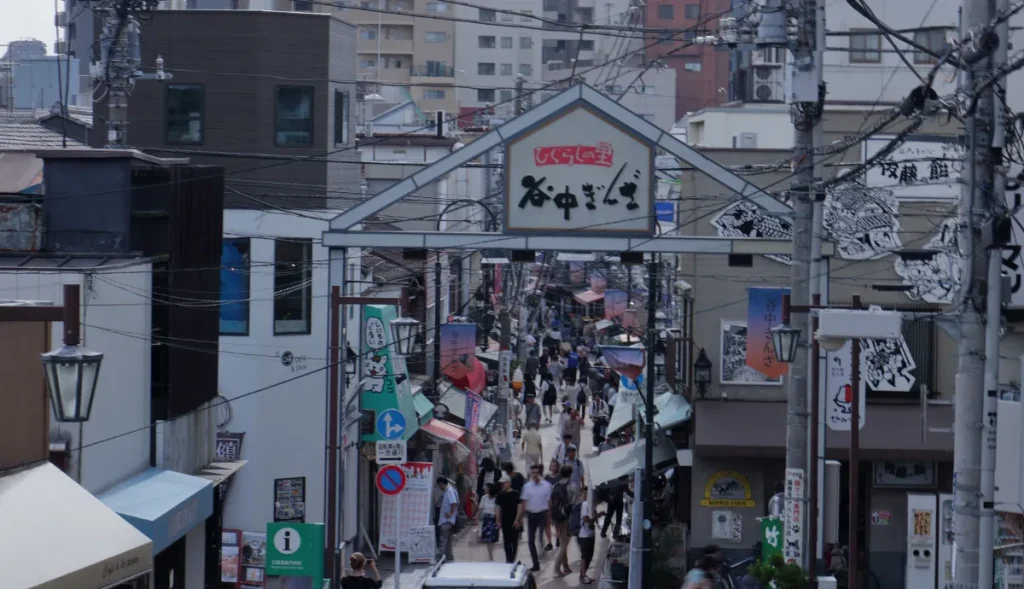Nightclub
- Best Nightclub in Tokyo
Lovehotel
- Best Lovehotel in Tokyo
Bar
Entertainment
Guide
Privacy Policy
Terms of Use
Content Creation Policy
Contact From

Tokyo’s vibrant food streets offer the opportunity to explore Japanese food and traditions.
From fresh seafood markets to historical places, you can enjoy authentic Japanese flavors at affordable prices.
This guide will give you a comprehensive introduction to the culture and must-see places of the best street food spots in Tokyo.
Make sure to add a food street to your Tokyo sightseeing itinerary and enjoy Japanese culture and food at the same time.

Food streets in Tokyo are vibrant thoroughfares dedicated to culinary exploration, where traditional Japanese street vendors, market stalls, and small eateries cluster together to create Tokyo’s unique street food culture.
These streets, often called “shotengai” or “yokocho” in Japanese, serve as the beating heart of Tokyo’s street food scene.
Many of Tokyo’s famous food streets have evolved from postwar black markets into integrated shopping and dining areas.
While still retaining their historical character, they also offer modern-day flavors and a clean atmosphere.
As you can get a variety of dishes in small portions, they are recommended for those who want to try the various gourmet foods of Tokyo.

Tokyo’s street food scene is known for its surprising diversity of cuisines.
Traditional street food staples include freshly grilled okonomiyaki, yakitori, takoyaki, and ramen.
Places like Tsukiji Market make fresh seafood readily available, enhancing the experience.
There are also modern, photogenic dishes, giving you a wide range of options from traditional to contemporary Japanese cuisine.
Tokyo is home to many iconic food streets, each offering its own unique charm and culinary delights.
Here are some of the best food streets in Tokyo to explore.
When planning your visit, consider your companions and the type of cuisine you’d like to enjoy for an unforgettable street food experience.

Tsukiji Outer Market remains one of Tokyo’s most iconic street food destinations, where over 400 food vendors and market stalls create an incredible culinary landscape.
While the main fish market moved to Toyosu, the outer market’s street food scene continues to thrive.
Famous for serving the freshest seafood-based street food in Tokyo, vendors here specialize in dishes like grilled scallops, fresh sushi, and tamagoyaki (rolled omelet)
You’ll find the best street food options early in the morning when vendors prepare fresh dishes using ingredients from the day’s market.
Walk about 5 min from Exit1, Tsukiji Station

Ameyoko is a historic food street that that originated as a black market after the war.
At Ameyoko, you can find a wide variety of street food options, from traditional Japanese food stalls selling fresh seafood and grilled meat to Korean, Chinese, Turkish street food and more.
There is also an izakaya next to Ameyoko that is open from noon where you can take a break and enjoy a drink.
If you want to enjoy tradition and food at a food street that is popular among Japanese people, we recommend Ameyoko.
Walk about 5 min from Ueno Station
Stretching for 1.3 kilometers, Togoshi Ginza is Tokyo’s longest shopping street and one of its most authentic street food destinations.
Famous dishes in Togoshi Ginza include deep-fried croquettes, crispy minced meat cutlets, and a unique oden croquette that blends traditional flavors with modern street food innovations.
Unlike Tokyo’s touristy street food streets, Togoshi Ginza maintains its local character and is one of the best places to experience authentic Tokyo street food culture.
For a true taste of Tokyo, head to Togoshi Ginza.
Walk about 7 min from Togoshi Station
The successor to Tsukiji Inner Market, Toyosu Market represents the modern evolution of Tokyo’s street food and market culture.
Though primarily a wholesale market, the facility also has a dining area where you can enjoy fresh seafood dishes provided by local food vendors.
It’s also close to the popular facility Team Lab, making it a popular sightseeing spot to combine the two.
If you’re looking to enjoy fresh seafood while sightseeing, Toyosu Market is a good choice.
Directly to the market from Shijo-mae Station

The historic district of Asakusa is a perfect blend of traditional Japanese culture and street food greatness.
The streets around Sensoji Temple are lined with stalls selling traditional Japanese snacks and regional specialties, offering one of the most authentic street food experiences in Tokyo.
The area’s food stall streets are packed with traditional Japanese street food stalls specializing in dishes such as ningyo-yaki, freshly baked rice crackers, and a wide variety of traditional sweets.
Asakusa is one of the most popular tourist destinations in Tokyo, so be sure to enjoy the street food along the way.
Walk about 5 min from Asakusa Station

Harajuku’s iconic Takeshita Street is the ultimate showcase of Tokyo’s modern and creative street food culture.
This bustling street is world-famous for its innovative, Instagram-worthy street food that blends Japanese and international influences.
Unlike Tokyo’s traditional food streets, Takeshita Street specializes in colorful and unique creations, such as rainbow cotton candy, giant rainbow cheese toast, and towering soft-serve ice cream.
For those seeking vibrant, photo-worthy treats, Takeshita Street is a must-visit destination.
Directly across from the station’s Takeshita Exit

Yanaka Ginza is a hidden gem that combines some of Tokyo’s best street food with a charming old-school Tokyo vibe.
Here, you can savor traditional street food, including local specialties like minced cutlets, freshly made croquettes, and whimsical cat-themed treats.
The street also features some pre-war architecture, giving you a glimpse of Japanese history.
The market’s friendly atmosphere and affordable food make it a great choice for travelers looking for an authentic street food experience.
Walk about 5 min from Nippori Station

Known as Tokyo’s Korea Town, Shin-Okubo is a unique blend of Japanese and Korean street food cultures, offering a diverse street food experience.
Shin-Okubo’s food stalls offer exciting combinations of Korean and Japanese cuisine, from traditional Korean street food such as tteokbokki (spicy rice cakes) to Japanese-Korean fusion dishes.
The area’s food stall streets come alive at night, with countless stalls offering an authentic Asian street food experience.
If you’d like to sample some Korean flavors during your trip to Japan, this is the place to go.
Walk about just 1 min from Shin-Okubo Station
Jizo Street in Sugamo is also known as “Grandma’s Harajuku,” and is a street lined with food stalls and clothing stores that are popular with the older generation.
The street’s street food options include freshly made buns, baked rice crackers, and unique local specialties like the famous “shio daifuku.”
Many of the food stalls and shops here have been operating for generations, offering flavors that are truly one-of-a-kind.
Jizo Street is a must-visit for anyone seeking to experience the timeless tastes of traditional Japanese street food.”
Walk about 5 min from Sugamo Station
Here are some frequently asked questions about Tokyo’s food street scene.
Many shops in Tokyo’s food streets close in the evening, so most places will not be open at night.
However, in tourist-heavy areas like Ameyoko and Takeshita Street, there are some shops that remain open until late, allowing visitors to enjoy street food even after sunset.
Some shops on Food Street provide chairs in front of the shop, but the number of chairs is limited.
As a result, it’s not always possible to sit down and relax while enjoying the food.
Street food in Tokyo is safe. Even food stalls are operated in clean environments and are very particular about food hygiene.
The level of cleanliness is far superior to other Asian food stalls, so you can eat from these stalls with confidence.
Many of the places introduced here are popular among locals. However, rather than focusing solely on eating, people often combine it with other sightseeing or activities.
Why not enjoy some street foods while sightseeing and truly experience the local atmosphere?
Tokyo’s street food scene represents an essential part of Japan’s culinary heritage, offering visitors an incredible variety of authentic experiences across its diverse food streets and market districts. From traditional vendors in historic streets like Asakusa and Yanaka Ginza to modern food innovations in Harajuku, Tokyo’s street food culture continues to evolve while maintaining its commitment to quality and tradition.
Whether you’re exploring the seafood specialists at Tsukiji Market, discovering local favorites in Togoshi Ginza, or sampling international flavors in Shin-Okubo, Tokyo’s food streets provide endless opportunities to experience Japan’s remarkable food culture. These vibrant street food destinations not only offer delicious and affordable dining options but also serve as windows into the heart of Tokyo’s dynamic culinary landscape.
Tokyo Nightlife is operated by the editorial team of Emotional-Link LLC.
Our team is made up of members who are well-versed in the dynamic nightlife of Tokyo and are based in Tokyo.
With extensive experience in both the tourism industry and living abroad, we strive to provide reliable information that truly meets the needs of international travelers visiting Japan.








Comments